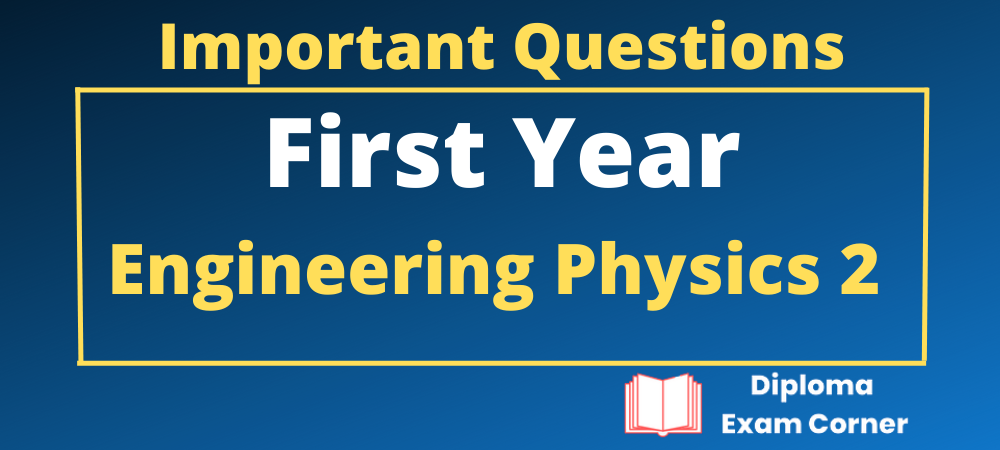Diploma Engineering Physics 2 Important Questions
Dear Students
We have added Diploma Engineering Physics 2 Important Questions for First Year Second Semester N scheme pattern.
Join our Google News , WhatsApp and Telegram Group For Regular study material Updates
Click here to Join us on Google News

Unit 1 Heat
One and two Marks
- What are the three scales of temperature?
- Explain the process conduction convection and radiation.
- Define coefficient of thermal conductivity
- Define specific heat capacity of solid
- State any three postulates of kinetic theory of gases
- Define Heat and temperature
- What are the good conductors of heat?
- Derive the relation between kinetic energy and absolute temperature of a gas.
15 Marks (7 and 8 marks)
- Derive an expression for pressure of a gas on the basis of kinetic theory of gases
- Show that Cp – Cv = R for a perfect gases
- Find the r.m.s velocity of hydrogen molecule at S.T.P if density of Hydrogen is 0.0899 kgm ^-3
- Write the properties of thermal radiation
- Derive Mayer’s relation (Cp-Cv=R)
- If the density of carbon dioxide at STP is 1.977 kgm^-3. Find the RMS Velocity of Carbon dioxide
- Explain the three modes of Heat transfer
- State the postulates of kinetic theory of gases
- Calculate the value of a universal gas constant ‘R’ from the gas equation PV = RT at STP
Unit 2 THERMODYNAMICS, LIQUEFACTION OF GASES and NONCONVENTIONAL
ENERGY
One and Two Marks
- Define First law of thermodynamics
- Define temperature of Inversion
- Explain Isothermal Changes
- Write the disadvantages of Renewable Energy sources
- State Clausius statement of second law of thermodynamics
- Explain adiabatic changes
- Give any three advantages of renewable energy
- Write an equation each for isothermal and adiabatic change.
- Explain the temperature of inversion and joule thomson effect.
- Explain the sources of renewable and non-renewable energies
15 Marks (7 and 8 marks)
- Air at 5 atmosphere is suddenly compressed to half of its original volume. Find the resulting of pressure. Take γ = 1.4
- Describe the Linde’s Process for the liquefaction of air
- Explain solar energy and Wind energy
- A gas at 1 atm pressure is compressed to 1/3 of its initial volume. Calculate the final pressure if the compression is (1) Isothermal (2) Adiabatic. Take γ = 1.4
- Explain the liquefaction of oxygen by cascade process
- Write short note on wind energy
- Explain the working of Carnot’s reversible engine with indicator diagram and write its efficiency.
- Write short note on Solar energy
Unit – 3 LIGHT AND REMOTE SENSING
one and two Marks
- Expand the acronym ‘RADAR’
- Explain spontaneous emission
- What is refraction of light?
- Expand RADAR and LASER
- Explain stimulated emission.
- Define refractive index
- Explain the three main parts of spectrometer.
15 marks(7 and 8 Marks)
- Calculate the refractive index of a prism, if the angle of the prism 59 degree and the angle of minimum deviation is 40 degree
- Describe the construction and working of a Ruby laser.
- Explain the data acquisition, data analysis and reference data
- Describe an experiment to determine the refractive index of a prism using spectrometer.
- Write the uses of LASER
- Describe the components of Remote sensing.
- Explain the phenomenon of total internal reflection.
- Explain spontaneous emission, stimulated emission and population inversion
- Explain the working of a RADAR with a block diagram.
Unit 4 ELECRICITY
One and Two Marks
- Define resistivity
- State any two merits of moving coil galvanometer.
- Explain the law of resistance connected in series.
- Derive an Expression for the effective capacitance when three capacitors are connected in series.
- State Fleming’s left hand rule.
- Explain super conductivity and Meissner effect.
- Derive an Expression for the effective capacitance when three capacitors are connected in Parallel.
- State Kirchoff’s current law.
- Define electrolysis.
- Explain the law of resistances connected in parallel
15 Marks (7 and 8 Marks)
- Derive the condition for balancing the Wheatstone’s bridge by using Kirchoff’s laws.
- Describe an Experiment to determine the electro chemical equivalent (e.c.e) of copper by using copper voltmeter.
- A galvanometer of resistance 50 ohm shows full scale deflection when a current of 1.5mA passes through it. How can it be converted into an ammeter to measure up to 2A?
- The resistance of a wire of 25m long 1mm diameter is 0.65Ω. Calculate its resistivity
- Describe an experiment to determine the specific heat capacity of a liquid using Joule’s calorimeter.
- Describe how a galvanometer can be converted into (i) an ammeter and (ii) a voltmeter.
- Derive an expression for torque experienced by a rectangular current carrying coil, placed in a uniform magnetic field.
- Describe an Experiment to determine the electro chemical equivalent (e.c.e) of an element
- Calculate the effective capacitance of three capacitors 1μF, 2 μF and 3 μF, Which are connected in series.
Diploma Board Exam Question Papers – Engineering Physics 2
Diploma Engineering Physics 2 June 2021 Question paper
Diploma Engineering Physics 2 February 2022 Question paper
